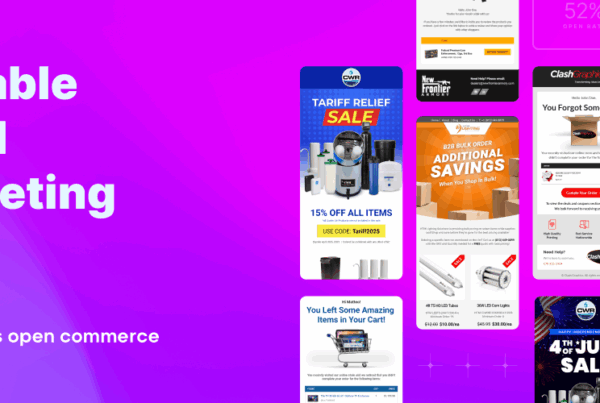Businesses are discovering the latest and innovative ways to engage with customers and drive sales online. From small startups to global giants, everyone is embracing the power of technology to enhance their e-commerce strategies.
Understand the role of technology in success. Inspect the convergence of technology and e-commerce, and the valuable insights and tips on how to navigate this landscape.
The duty of technology in e-commerce
Technology has transformed how we do business, and e-commerce is no exception. It’s safe to say that technology is the backbone of modern-day online retail. From setting up a user-friendly website to streamlining inventory management and order fulfillment processes, technology enables businesses to operate smoothly and efficiently.
It creates an agreeable and personalized shopping experience. With sophisticated algorithms and data analytics tools, businesses can collect valuable insights about their target audience’s preferences, behavior patterns, and purchase history. They can tailor their marketing messages, suggest relevant products, and provide a smooth browsing experience that keeps customers coming back.
Furthermore, technology facilitates secure online transactions. Payment gateways ensure that sensitive customer information remains confidential while enabling convenient payment options like credit cards or digital wallets. This level of security instills trust in customers’ minds when making online purchases—a vital factor in driving sales.
Another significant aspect where technology shines is automation. E-commerce platforms often integrate with inventory management systems to ensure real-time updates on product availability and automate reordering processes when stock levels are low. This minimizes manual errors while saving time for business owners who can focus on other critical aspects like customer service or expanding their product range.
Additionally, technologies such as artificial intelligence (AI) chatbots have transformed customer support within e-commerce. These intelligent bots are capable of answering frequently asked questions promptly without human intervention—improving response times while reducing operational costs.
How to begin with e-commerce
Starting an e-commerce seems overwhelming, but it can be transformative. Here are steps to help you embark on your business journey.
Defining Your Niche
You need to define your niche and target audience. Understanding who your customers are will guide every decision you make along the way. Conduct market research to identify trends, analyze competitors, and determine what sets you apart.
E-commerce Platform
Next, choose an e-commerce platform that levels with your objectives and resources. Popular options are Shopify, Magento, and BigCommerce. These platforms offer user-friendly interfaces and provide customizable templates to create a visually appealing online store.
Compelling Product Descriptions
Once you’ve set up your online store, focus on creating compelling product descriptions and high-quality images that showcase your offerings effectively. Invest in professional photography if possible or explore tools like Canva for editing images yourself.
Secure Payment Gateways
To ensure a seamless shopping experience for customers, integrate secure payment gateways such as PayPal or Stripe into your website. This will give shoppers confidence in making transactions on your site.
Search Engine Optimization
Don’t forget about marketing! Utilize social media channels like Instagram or Facebook ads to drive traffic to your website. Implement search engine optimization (SEO) strategies by optimizing keywords relevant to your products throughout your website content.
Remember that starting an online business is an ongoing process involving continuous learning and adaptation. Stay open-minded as technology evolves rapidly in this space – embrace new features and functionalities that can enhance user experience on both desktops and mobile devices alike.
What are common e-commerce platforms?
When setting up an e-commerce business, choosing the right platform is the initial step. There are common platforms.
BigCommerce. This platform has been revolutionizing the online retail space with its flexible features and user-friendly interface. With BigCommerce, merchants can effortlessly set up their virtual storefronts and unleash their entrepreneurial potential.
Shopify. Acknowledged for its simple interface and powerful functionality, Shopify lets you easily create and customize your online store. It has a range of templates and themes, making it effortless for beginners to design a professional-looking website.
Magento. The ideal choice for more advanced features and scalability options. As an open-source platform, Magento gives businesses the flexibility to customize their online stores according to their specific needs. It also offers impressive marketing tools and integration options with third-party applications.
Before selecting, consider pricing plans, payment gateway integrations, security measures, and customer support. Choose a platform that provides all the necessary features for a successful online store.
Shipping options for e-commerce
Shipping is a crucial aspect of e-commerce that directly impacts customer satisfaction and the success of online businesses. There are several shipping options.
One common shipping option is partnering with established courier services such as USPS, UPS, or FedEx. These companies offer reliable and efficient delivery services worldwide. They provide various shipping methods like standard ground, expedited, or overnight delivery based on customer requirements.
Another popular option is dropshipping. With dropshipping, the retailer doesn’t hold inventory but instead transfers orders to a supplier who directly ships products to customers. This eliminates the need for warehousing and streamlines the fulfillment process.
ShipperHQ is an innovative platform that gives online businesses access to a plethora of exciting shipping possibilities. With its cutting-edge technology, merchants can integrate with carriers worldwide. Whether it’s expedited overnight shipping for those last-minute gift shoppers or economical ground transportation for budget-conscious buyers, ShipperHQ has got every angle covered.
For smaller businesses or those starting out in e-commerce, utilizing postal services can be cost-effective. Postal services like USPS offer affordable shipping rates for domestic and international shipments while providing tracking information for packages.
The right shipping options for your online business will depend on budget constraints, target market location, product types and more. Technology solutions and exploring various shipping strategies shows the most suitable approach that ensures smooth order fulfillment processes with timely deliveries!
Stay Ahead of the Curve
Staying ahead in technology and e-commerce can be challenging, but you can be successful with the right strategies. Here are tips on staying ahead:
1. Embrace innovation: Technology evolves, so keep up with the current trends and advancements. Stay tuned about emerging technologies such as artificial intelligence, virtual reality, and blockchain that could disrupt e-commerce.
2. Adaptability is key: As new technologies emerge, be ready to adapt your business model accordingly. Explore ways to streamline processes, enhance customer experiences, and improve overall efficiency with technology.
3. Invest in research and development: Allocate resources towards research and development efforts to understand market trends and customer needs. This identifies opportunities for growth and innovation within your industry.
4. Foster a culture of continuous learning: Encourage employees to expand their knowledge through training programs or attending industry conferences. Fostering a culture of continuous learning within your organization ensures that everyone stays updated on technological advancements relevant to your business.
5. Prioritize cybersecurity: With increased reliance on technology comes an increased risk of cyber threats such as data breaches or hacking attempts. Make sure you have strong security measures in place to protect sensitive customer information and maintain trust.
6. Leverage data analytics: Utilize tools like web analytics platforms or customer relationship management (CRM) systems to gather insights from user behavior patterns, purchasing habits, or market trends. These insights can help inform decision-making processes and guide strategic initiatives.
7. Communicate effectively with customers: Engage with customers through various channels such as social media platforms or email marketing campaigns where appropriate offers can be made based on their preferences identified through data analysis
Proactively implementing these strategies positions you at the forefront of technological advancements within the e-commerce realm. In doing so, you’ll not only meet the ever-changing demands of customers but also gain a competitive edge in an increasingly saturated market.
At Always Open Commerce, we have certified developers, expert designers, and product data managers to help you get started with your e-commerce business or migrate to a better platform for established names.












